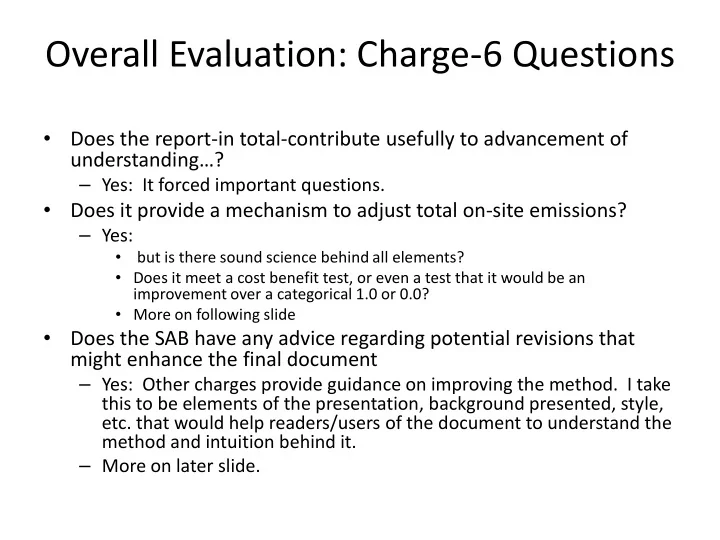

Overall Evaluation: Charge-6 Questions Does the report-in total-contribute usefully to advancement of • understanding…? – Yes: It forced important questions. Does it provide a mechanism to adjust total on-site emissions? • – Yes: • but is there sound science behind all elements? • Does it meet a cost benefit test, or even a test that it would be an improvement over a categorical 1.0 or 0.0? • More on following slide Does the SAB have any advice regarding potential revisions that • might enhance the final document – Yes: Other charges provide guidance on improving the method. I take this to be elements of the presentation, background presented, style, etc. that would help readers/users of the document to understand the method and intuition behind it. – More on later slide.
Are all elements of the method based on sound science. The method offers no sound way to define a region, and how a region is • defined makes a huge difference as we saw from case studies. – Is there a scientific foundation for defining a region? What justification is there for using an average regional value for land use • emissions/uptake. – Scientifically these should reflect what happens on the land that is actually supplying biomass to the point source. What justification for not crediting uptake if a region is positive? • – This appears arbitrary or based on an assessment that it is not fair that point sources get credit for this uptake—but is it “fair” to penalize a point source for land mismanagement that they did not control—fairness in eye of beholder? Implicitly the method assumes fossil energy related emissions and • biogenic emissions from products of points sources will be controlled by other measures or are not relevant but not upstream—land use related changes in carbon. – What justification for this differential treatment? – Even if we stick to biogenic CO2, if the boundaries of the point source can be expanded upstream why not down stream—to emissions from by-products, co-products, or products? Ethanol combustion, DDGs in animal feed that will soon become CO2 (or CH4)
Does the report demonstrate that the revised method meets a cost benefit test or even a test that applying this method will reduce atmospheric carbon compared with a categorical 0 or 1 • No evidence is presented on cost-benefit or even if there is an improvement. • Imprecise, and irrelevant regional factors could be wrong in either direction. • Moving to more precise and relevant measures is very costly, or would require a very burdensome sourcing of biomass for a point source and monitoring carbon stocks on these parcels indefinitely—high cost to improve fidelity— worth it? • The potential for significant behavioral response to avoid a high BAF could seriously undermine its effectiveness— behavior to avoid high BAF is a bias in one direction and no assessment of this bias.
Key question EPA asked us to answer? • Is this method better than a categorical 1 or 0? (or can it feasibly be or meeting some cost benefit test.) – Yes – Yes with some modifications – Possibly yes but many unanswered questions – No • If no – Categorical 1 or categorical 0.
Improvements to the document. The document is wordy and more complex than it needs to be. • Better statement of objective and where they are heading at the • front. Useful to point out that this is in response to EPA’s requirement to regulate GHG emissions under the Clean Air Act…and what that is. Formula not very intuitive. • I understand attempt to keep this policy neutral but because how • to account depends on the policy framework, not clear that the system can be evaluated absent an expectation about the policy environment, and a lot of those expectations of EPA are unstated reasons for decisions they have made—those should be stated explicitly – Can be very clear that these are not decided but that the method proposed is based on these assumptions about the more complete policy framework. – Then clear that the method would need to be amended if the policy framework is different or changes.
Some General Comments EPA Staff have done an admirable job of tackling a very complex assignment. • Their significant challenge is to create an accounting system that ultimately would • be used in a regulatory system that is not well-defined, and is likely to be highly incomplete (covering some GHGs/sources but not all), but at this point is some implementation of the Clean Air Act. An important complication is that the accounting system attempts to apply • responsibility to things that happen on the land, to a point source, for which the agent who owns that point source has no direct control. If land use emissions/uptake were controlled directly then, under some conditions, • there would be no reason to include this in estimates related to point source emissions==applying zero at the point source. I.e. This problem arises because of the anticipation of incompleteness in the GHG control system. Estimating an individual point source’s BAF based on average data in a region is • highly problematic. In general it ought to be specific to suppliers to the point source. • In general, the accounting system ought to be based on observable and measured • changes rather than projections and these are not available from public sources at the resolution level required. Dynamics need to be addressed through regular update of BAF, and ongoing • liability for/accounting of suppliers to the point source.
Recommend
More recommend